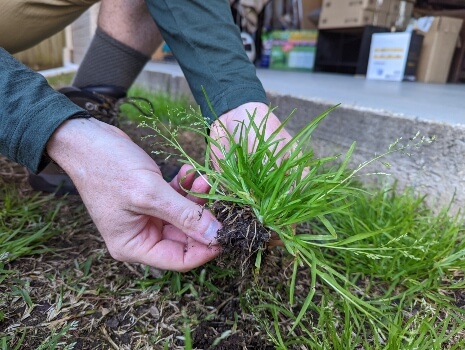Winter grass or annual bluegrass can be an absolute pain to deal with in our turfs, especially in the cooler months. These prolifically seeding plants quickly become invasive and hard to manage if left untreated, making them one of the worst seasonal weeds occurring widely throughout Australia.
Luckily, there are a few tried and tested ways in which gardeners can combat these pesky invaders without too much hassle if treated at the correct time that is. Today, I will be detailing how you can identify, prevent and treat winter grass lawn invasions in your landscape at home. Let’s get started.
More...
What is Winter Grass?

Botanically labelled, Poa annua, winter grass is now also commonly referred to as annual bluegrass in many areas. This vigorous plant species is widespread in Australia, spreading predominantly throughout the cooler autumn and winter months. Invasions do tend to occur to a greater extent in more temperate climates.
Winter grass is a low-growing turf grass with soft and slightly arched green leaves that form in small tufts with triangular seed heads. Growers and homeowners that have become aware of Poa annua in their gardens know all too well that early combat is the most effective way to deal with this weed.
When Does Annual Bluegrass Appear?
Winter grass is a highly versatile species that has the potential to germinate in all areas of the lawn, from full sun locations to even heavily shaded spots around the garden. It attacks lawns prominently in winter.
Unfortunately, most will experience and have to deal with Poa annua at some point. Attacks can leave a lot to be desired in lawns as they can quickly create a patchy, unappealing appearance within gardens.
The weed can begin germinating as early as March in some areas, emerging and forming tufts within your lawn as temperatures begin to drop. Spread will continue throughout the winter months. Upon germination, winter grass will appear light green in colour with soft, droopy leaves forming in loose tufts.
As it matures, it will become thicker with a more densely tufted, upright appearance. This is what you’ll want to avoid. Early treatment is the key to preventing winter grass from coming back stronger and more prolific next winter.
How to Get Rid of Winter Grass
The trick is to treat or remove annual bluegrass before it goes to seed or during germination, while it is still young with light green leaves. If the seeds are left to dry, they will quickly spread and become invasive across your lawn, coming back next winter often twice as bad.
Apply herbicides in spring then repeat in autumn and treat throughout winter as recommended by the specific product being used.
Removing Poa annua by Hand
These weeds can be removed easily by hand as the roots are shallow and the plant does not produce any runners. It will form in simple, easy-to-manage clumps that are best weeded out as soon as possible while the seeds are still green. This should prevent further spread.
Be sure to gently lift the tufts using your weeding tool to get all the roots. Hand removal is a simple and organic way to remove winter grass and is best used in cases of smaller invasions.
Make sure you dispose of the removed weeds properly off-site. They can go in your green bin but be sure not to pop them in your compost bin otherwise they could be back next year.
Winter Grass Treatment Using Herbicides
In more severe cases, hand removal can become tedious and time-consuming, this is when treating your lawn with specifically targeted herbicidal controls or sprays is often the best solution. These herbicides are usually found in pre- and post-emergent varieties.
In situations where Poa annua has spread thoroughly in lawns, a post-emergent treatment or winter grass weed killer will be necessary whereas prevention is best achieved using pre-emergent products.


Get Your Free Guide:
Master Growing Australian Natives eBook
A Must Have Complete Guide for Every Australian Garden
Get Your Free Guide:
Master Growing Australian Natives eBook
A Must Have Complete Guide for Every Australian Garden
Two great post-emergent herbicides could be the SureFire Glyphosate Herbicide Weed Killer or the Roundup Advanced Concentrate Weed Killer, both of which are available online.
Poa annua Prevention Using Herbicides
To prevent annual bluegrass from spreading further or to target it before it even emerges, you will need to apply a pre-emergent herbicide to your lawn for the best results. This will ensure germination is prevented which means the plant won’t have the chance to go to seed.
A pre-emergent like the Scotts WeedEx Preventor is a good option that is also available online. Alternatively, speak to your local professionals to see what they might recommend.
Read our in-depth guide on weed killers and learn how to properly use them without harming wilflife.
Combination Treatment
In larger lawns where winter grass has spread densely, you can use a combination of pre-and post-emergent herbicides to selectively control the area to ensure total eradication of the weed.
Winter Grass Frequently Asked Questions

Why is winter grass a problem?
Winter grass is an ugly and unsightly weed with a clumping characteristic that can quickly overtake your lawn. It can take a beautiful lawn and transform it into a complete mess of weeds in a short period.
Does winter grass come back every year?
Yes. These weeds seed prolifically and can return worse the following year if left untreated and left to spread.
How do I get rid of Poa annua?
Hand removal or targeted herbicides tend to be the most reliable solutions. However, mulching can also be an effective control method as it prevents seed germination by blocking sunlight from the soil.
Can you mow Poa annua?
Mow your lawn as soon as the seedlings are tall enough to mow. Mowing will cut off some of the seed heads and help prevent them from going to seed.
Should you pull out winter grass?
If you have located winter grass early before it has flowered and gone to seed, you can simply use a garden shovel and dig it up manually then dispose of the weeds off-site. This is the easiest way to remove winter grass in its early stages.
How long does it take to get rid of Poa annua?
These tough seeds are capable of surviving many seasons in the soil without even germinating. Full eradication can take time, usually, in more severe cases it can take two to three seasons to start seeing big improvements.
Will Poa annua go away on its own?
It will normally die off in the summer when the temperatures get hot, leaving behind bare spots on your lawn. However, if you don’t remove or treat these weeds, they will most likely return next season.
Is crabgrass the same as Poa annua?
Winter grass (Poa annua) blades can look very similar in shape and size but crabgrass will look more like miniature corn stalks as it matures whereas winter grass remains clumped.
How deep are Poa annua roots?
Established clumps have roots that can easily occupy the top 5 cm of surface soil.
Will scarifying remove Poa annua?
By raking or scarifying your lawn, you will be able to make Poa annua more visible as it will force the tufts that are laying horizontally to stand up vertically towards their natural forms.
Wrapping Up Our Winter Grass Weed Control Guide
Now that you have a good understanding of how to identify, prevent and treat winter grass invasions, I hope you can effectively rid your lawn of these pesky weeds or prevent them from ever becoming a problem in your outdoor spaces.
Remember to use the hand removal method in cases of small spread and do this when the tufts are still young before seeding. For more severe cases of winter grass, pre- and post-emergent herbicides should offer reliable control in your garden.
Published on December 15, 2022 by Nathan Schwartz
Last Updated on February 2, 2025




